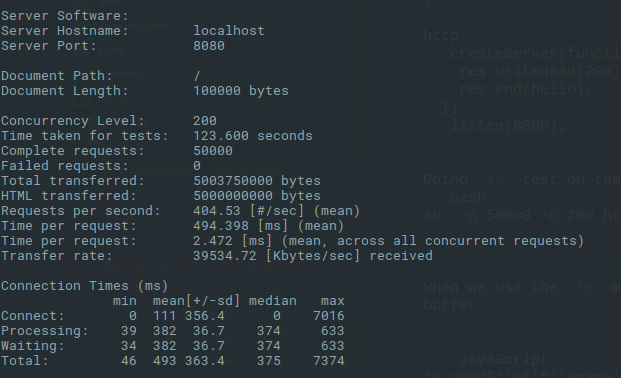

It does not change when the contents of the buffer are changed. length refers to the amount of memory allocated for the buffer object. Note that this is not necessarily the size of the contents. Otherwise, a RangeError will be thrown here.Ĭopies the passed buffer data onto a new Buffer instance.Īllocates a new buffer containing the given str. Note that the size must be no more than kMaxLength. ExampleĪllocates a new buffer of size octets. If undefined, the targetStart and sourceStart parameters default to 0, while sourceEnd defaults to buffer.length. Copies data from a region of this buffer to a region in the target buffer even if the target memory region overlaps with the source. SourceEnd − Number, Optional, Default: buffer.length SourceStart − Number, Optional, Default: 0 TargetStart − Number, Optional, Default: 0 TargetBuffer − Buffer object where buffer will be copied. When the above program is executed, it produces the following result −įollowing is the syntax of the method to copy a node buffer −īuf.copy(targetBuffer)

ExampleĬonsole.log(buffer1 +" comes before " + buffer2) Ĭonsole.log(buffer1 +" is same as " + buffer2) Ĭonsole.log(buffer1 +" comes after " + buffer2) If there is not enough space in the buffer to fit the entire string, it will write a part of the string. This method returns the number of octets written. Defaults to buffer.length.Įncoding − Encoding to use. Length − This is the number of bytes to write. Offset − This is the index of the buffer to start writing at. String − This is the string data to be written to buffer. Here is the description of the parameters used − Writing to Buffers Syntaxįollowing is the syntax of the method to write into a Node Buffer −īuf.write(string) Though "utf8" is the default encoding, you can use any of the following encodings "ascii", "utf8", "utf16le", "ucs2", "base64" or "hex". Var buf = new Buffer("Simply Easy Learning", "utf-8") Var buf = new Buffer() įollowing is the syntax to create a Buffer from a given string and optionally encoding type − Method 1įollowing is the syntax to create an uninitiated Buffer of 10 octets −įollowing is the syntax to create a Buffer from a given array − Node Buffer can be constructed in a variety of ways. Node provides Buffer class which provides instances to store raw data similar to an array of integers but corresponds to a raw memory allocation outside the V8 heap.īuffer class is a global class that can be accessed in an application without importing the buffer module. While dealing with TCP streams or the file system, it's necessary to handle octet streams.

Here's how you can convert a file to base64 encoding using Node.js: const fs = require( 'fs') īuf.toString( 'base64') // 'ewogICJuYW1lI.Pure JavaScript is Unicode friendly, but it is not so for binary data. toString() is converting a file to base64 so it can be used as an email attachment. If that's your use case, try allģ different encodings and see if any of them look familiar. Used for debugging and trying to figure out what the contents of the buffer mean. Which encoding is correct depends on your use case and the data stored in the buffer. toString('hex'), you get a string representation of the buffer where each byte is encodedĪs 2 hexadecimal characters. The most commonly used are:įor example, by calling. Node.js supports numerous different encodings for buffers. const fs = require( 'fs') Ĭonst buf = fs.readFileSync( './package.json') īuf.toString( 'utf8') // '' It determines what format Node.js uses to express The toString() method's first parameter is a string called encoding. const buf = om( 'Hello, World', 'utf8') īuf.toString() // 'Hello, World' The encoding Parameter For example, if you create a bufferįrom a string using om(), the toString() function gives you the original string back. Buffers have a toString() method that you can use to convert the bufferīy default, toString() converts the buffer to a string using UTF8 encoding. Node.js buffers are objects that store arbitrary binary data.


 0 kommentar(er)
0 kommentar(er)
